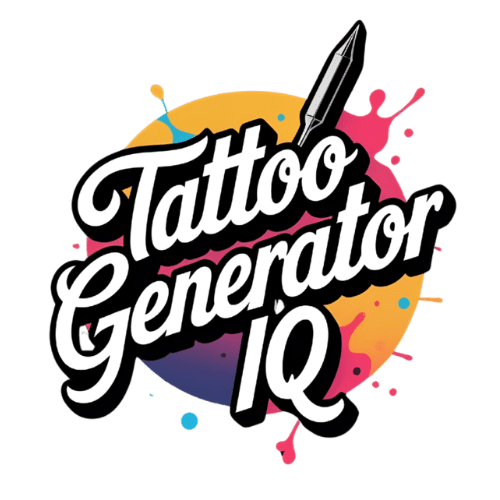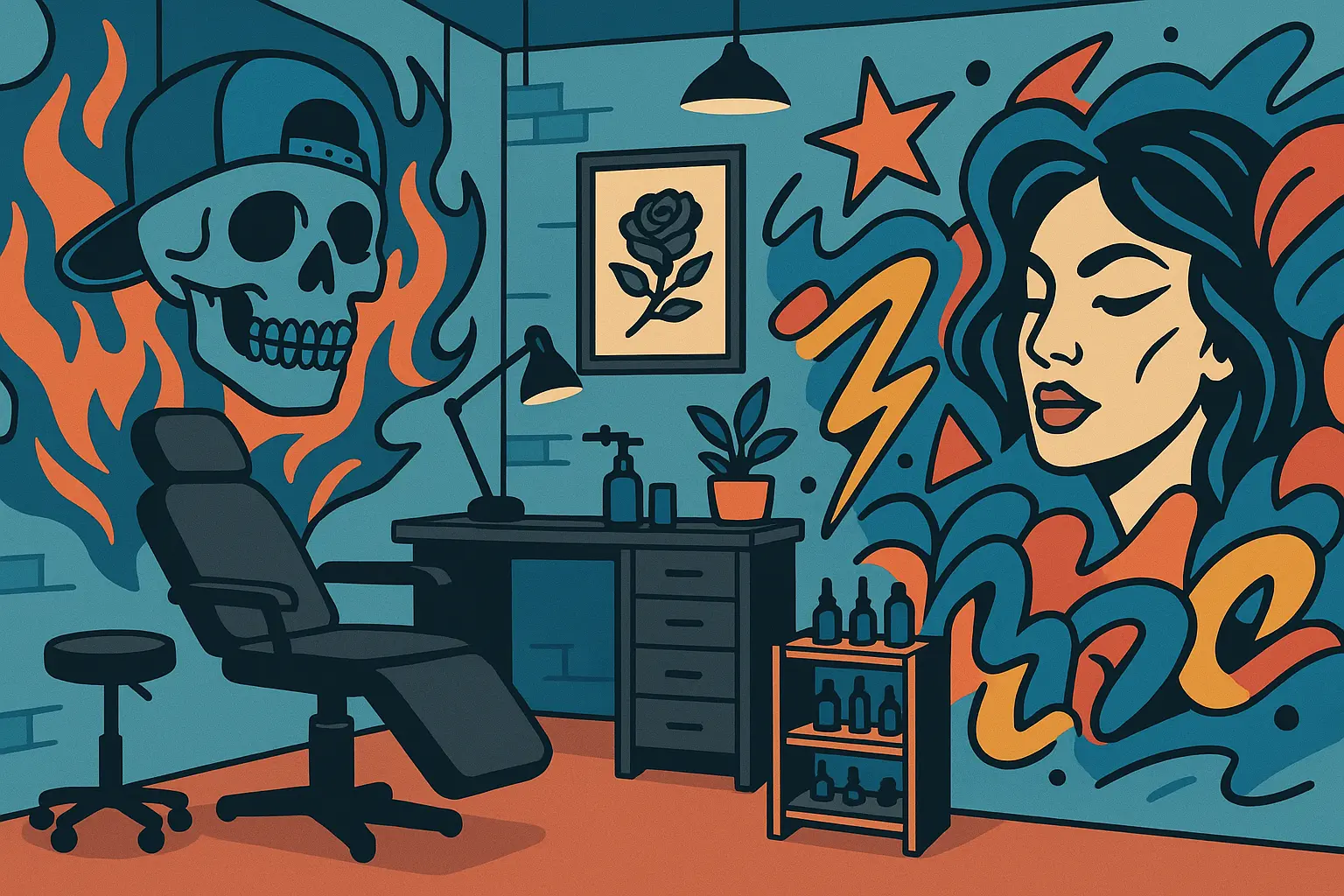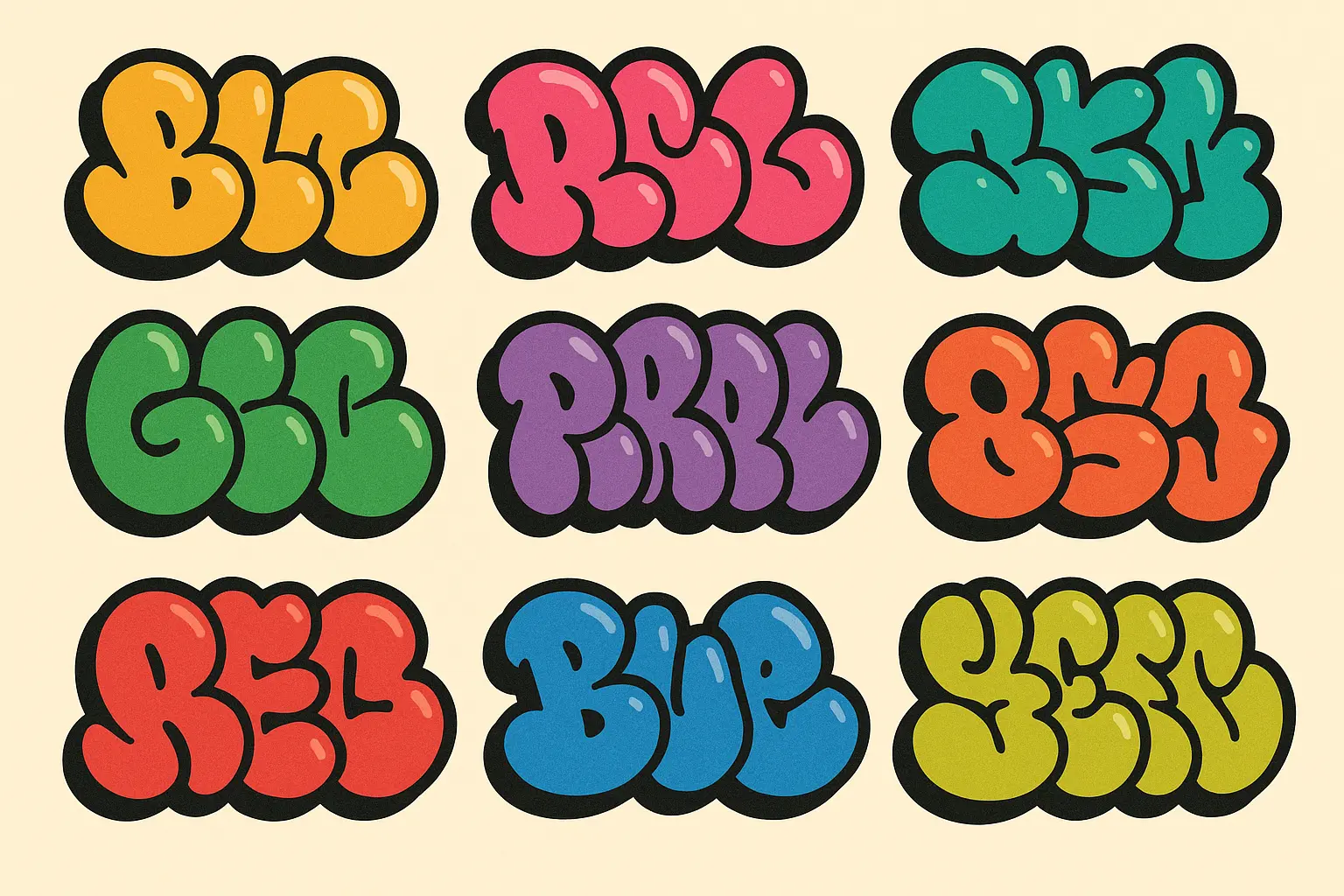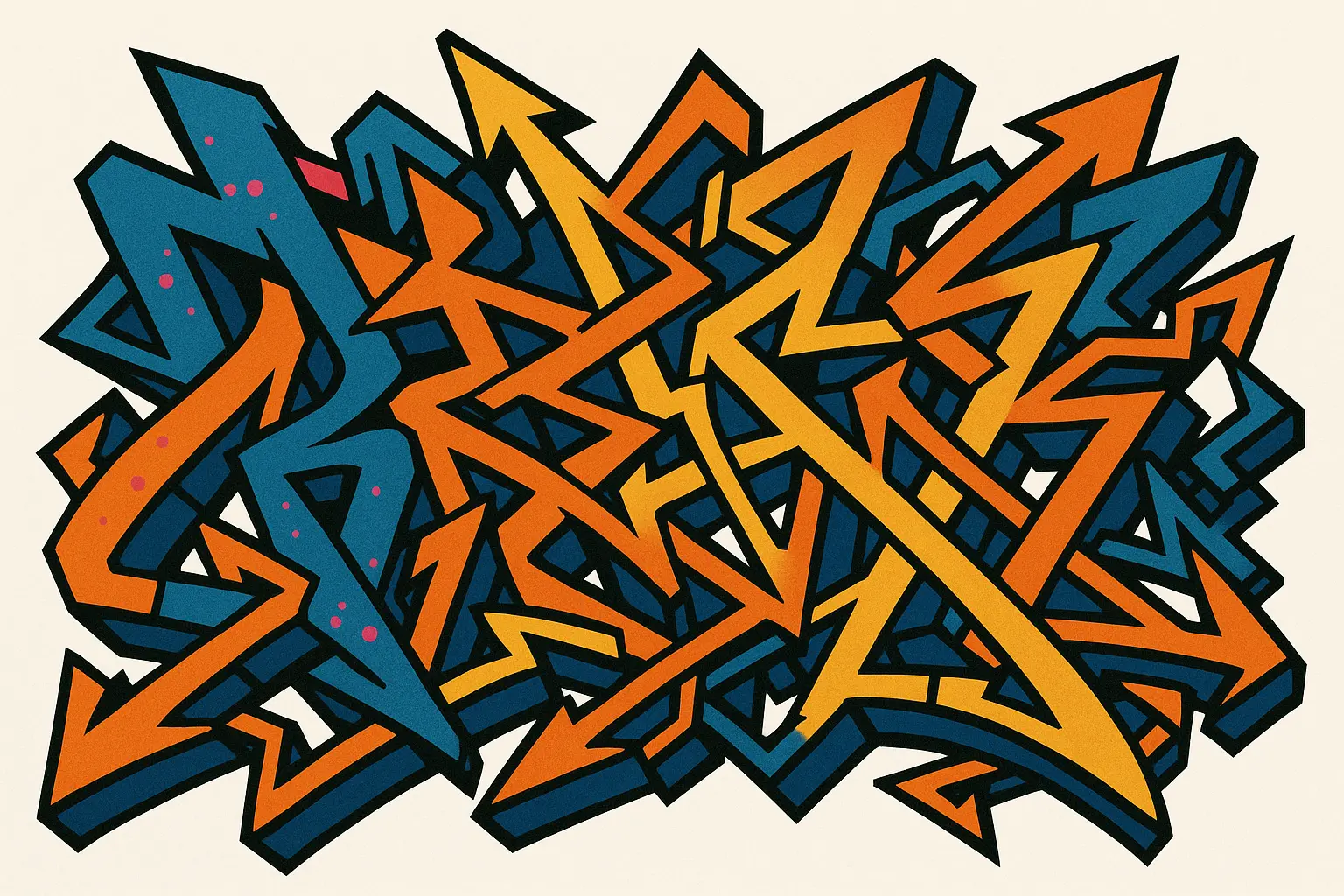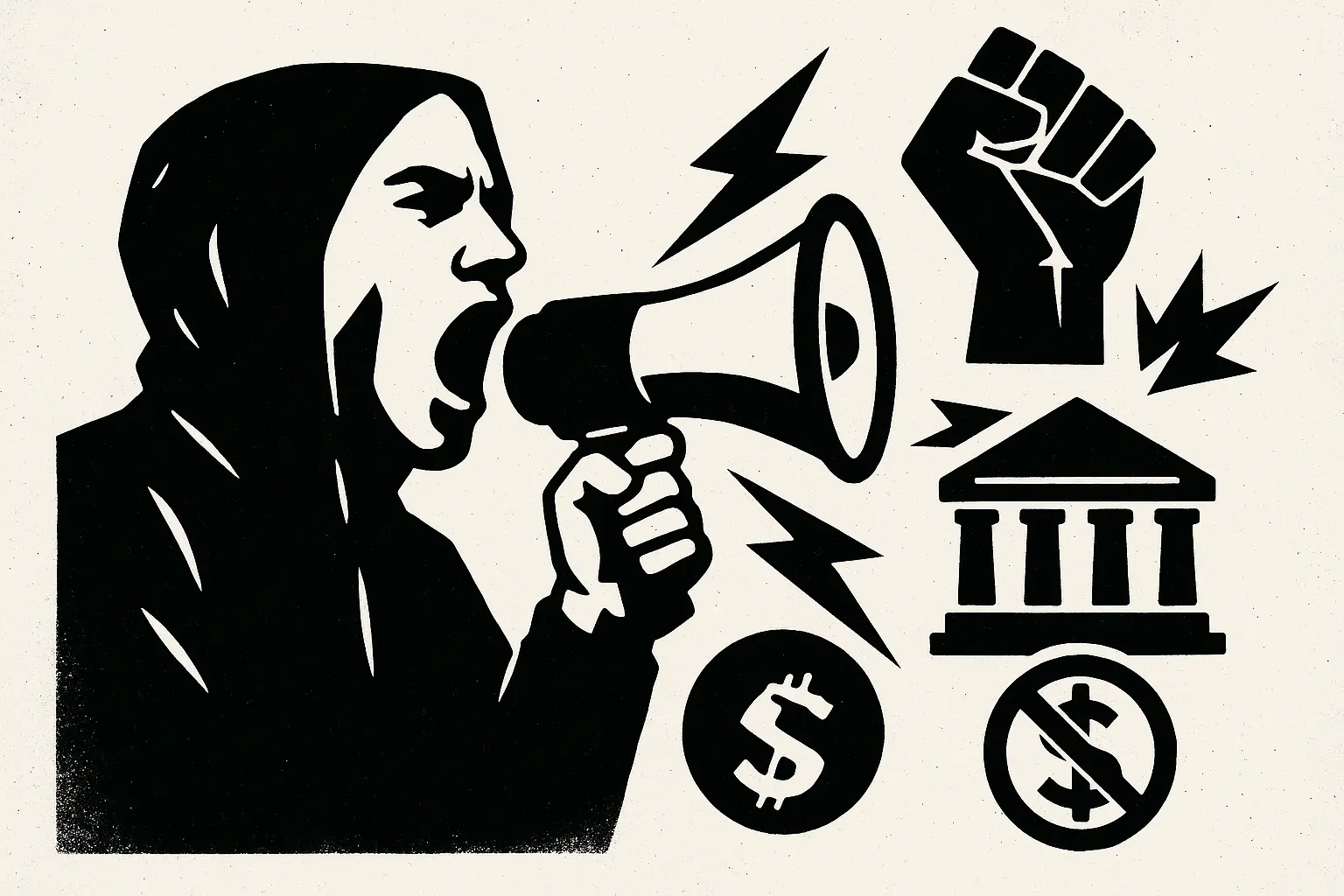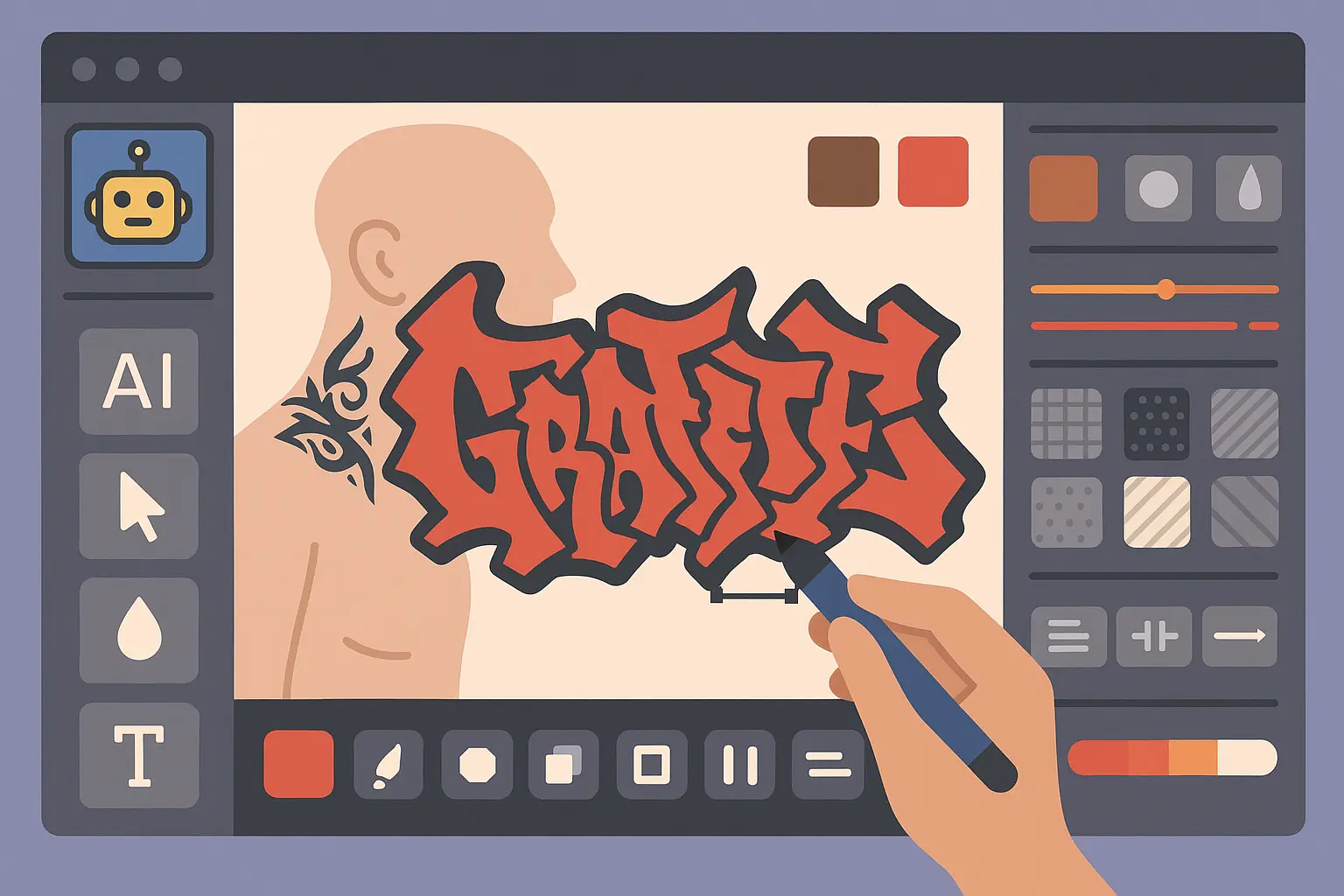25 Best Graffiti Tattoos That’ll Make You Stand Out From the Crowd
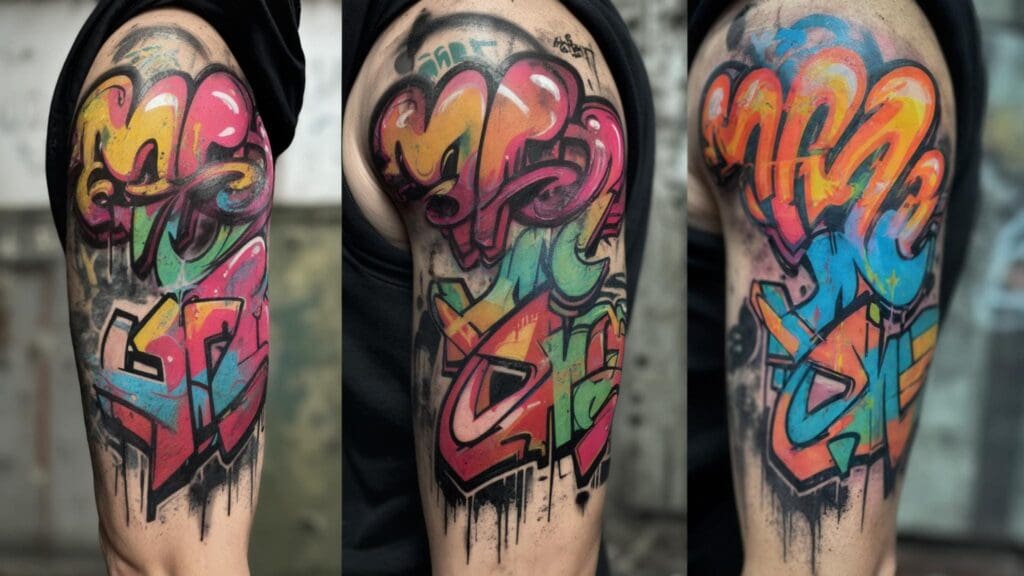
I remember the first time I walked into that Brooklyn tattoo shop and saw wildstyle pieces covering every wall. It hit me right then – my love for street art could literally become part of me. Turns out I’m not alone in feeling this way. According to Alan Ket, co-founder of Wynwood’s Museum of Graffiti, “people who co-exist in both [graffiti and tattoo worlds] is a special group, a group that has been growing for the past 40 years as graffiti artists have discovered that their rebelliousness or anti-conformist attitude works pretty well in the tattoo world.” Source
The thing is, graffiti and tattoo culture go way deeper than just looking cool. Both are about saying “this is me” in a world that wants everyone to look the same. When you get a graffiti tattoo, you’re not just getting some ink – you’re joining a movement that’s been evolving for over four decades.
I’ve spent years checking out graffiti tattoos, talking to artists who actually know their stuff, and watching how different styles hold up over time. Here’s what I’ve learned: not all graffiti tattoos are created equal. Some look sick when they’re fresh but turn into unreadable blobs within a few years. Others stay crispy for decades while actually honoring the culture instead of just copying it.
Table of Contents
-
What You Need to Know Before Getting a Graffiti Tattoo
-
Classic Bubble Letter Designs (5 designs)
-
Wildstyle and Complex Lettering (5 designs)
-
Throw-up and Quick Style Pieces (4 designs)
-
Stencil and Street Art Inspired (4 designs)
-
American Graffiti and Cultural Fusion (4 designs)
-
Modern and Contemporary Fusion (3 designs)
-
The Real Talk Breakdown
-
How Tattoo Generator IQ Can Help You Not Mess This Up
-
Final Thoughts
TL;DR
-
Not every tattoo artist can handle graffiti work – you need someone who actually gets the culture and has the skills to pull it off
-
Bubble letters are your safest bet – they age like fine wine and work great for beginners, while wildstyle needs a master-level artist
-
Where you put it matters big time – curved spots can make your letters look weird, flat surfaces are your friend
-
Don’t be a culture vulture – respect the art form without stealing specific crew tags or stepping on toes
-
Size isn’t negotiable – wildstyle needs at least 6-8 inches or it’ll be unreadable, throw-ups can work smaller
-
New fusion styles are cool but risky – we don’t know how they’ll age compared to tried-and-true approaches
-
Classic American styles have proven staying power – decades of street evolution backs up their look
What You Need to Know Before Getting a Graffiti Tattoo
Look, before you jump into this, there are five things that’ll save you from making expensive mistakes and hating your tattoo later. I’m talking about technical stuff that matters, cultural respect, where to put it, finding the right artist, and thinking about the long game.
Each of these directly affects whether your graffiti tattoo will look dope, age well, and actually connect you to the culture instead of just looking like you’re trying too hard.
Here’s the Thing About Graffiti Tattoos – They’re Tricky
Graffiti tattoos aren’t your average ink job. The lines need to be crispy clean, or your piece is gonna look amateur from day one. Sharp lines and proper proportions are everything – they’re what keep your tattoo looking fresh as it ages.
Think about it this way: thick outlines resist blurring way better than tiny details. That’s why bubble letters with bold edges still look sick decades later, while complex wildstyle connections might blur together if they’re not sized right.
Understanding pain levels for different body areas becomes crucial when you’re picking where to put complex lettering, since your artist needs steady hands and you need to sit still during those long sessions.
Real Talk Breakdown:
-
Bubble letters: Easy on the artist, ages great, 3-5 inches minimum
-
Wildstyle: Needs an expert artist, ages good if done right, 6-8+ inches minimum
-
Throw-ups: Sweet spot of difficulty and aging, 4-6 inches works
-
Stencil work: Tricky to execute, needs 4-7 inches
-
Modern fusion: Roll the dice – we don’t know how these age yet
Don’t Be That Person With a Fake-Looking Graffiti Tattoo
Authentic graffiti tattoos actually look like street art, not some generic “graffiti font” you found online. Do your homework on different graffiti movements so you understand what you’re representing. This keeps you from being disrespectful while making sure your tattoo honors the culture’s history.
Here’s a perfect example: copying someone’s actual tag like “WILD” without permission? That’s a no-go if you’re not part of their crew. But creating your own lettering using wildstyle techniques – maybe your name or something meaningful to you – while using those authentic arrow connections and letter flow? That’s showing respect while making it your own.
Don’t jack specific crew tags or culturally sensitive designs. Focus on style elements that celebrate what graffiti’s about without stepping on anyone’s toes.
Location, Location, Location
Where you put this thing on your body makes a huge difference in how the letters read and age. Curved areas can mess up letter shapes, while flat surfaces are perfect for complex designs.
Size requirements aren’t suggestions – they’re rules. Wildstyle pieces need serious space or they’ll be unreadable. Simple throw-ups can work smaller. Also think about visibility – do you want this front and center or more lowkey?
For bigger pieces, checking out shoulder tattoo placement options can show you how graffiti lettering works on curved versus flat areas.
Finding an Artist Who Won’t Butcher Your Vision
This is make-or-break time. You need an artist with clean line work, lettering experience, and actual understanding of street art. The best graffiti tattoos come from artists who get the culture, not just someone copying pictures.
Ask potential artists about their graffiti knowledge and lettering experience. Artists who actually understand the culture will produce way better results and can guide you toward designs that’ll age well without disrespecting anyone.
Think About the Future
Will your graffiti tattoo stand alone or connect to future pieces? Lots of people build collections over time, creating themes or expanding single pieces into larger compositions.
Think about yourself too. Will this still represent you in ten years? Graffiti keeps evolving, but certain foundational elements are timeless. Pick designs that balance current appeal with lasting relevance.
Classic Bubble Letter Designs
Bubble letters are like the reliable friend of graffiti tattoos – they originated from 1970s New York subway culture and they’ve been solid ever since. These five designs age incredibly well because of their bold outlines and simple forms, making them perfect if this is your first graffiti tattoo.
From basic single-color approaches to complex character integrations, bubble letters give you versatility while keeping it real with authentic street art connections. Plus, most decent artists can handle them without breaking a sweat.
1. Traditional Bubble Name
This is graffiti 101 – your word in rounded, inflated letters with thick black outlines. You can add color fills for personality while keeping that classic look that started the whole movement.
This design is all about simplicity and longevity. Those thick outlines fight off aging effects while the readable letters ensure your tattoo stays clear for decades. Perfect for names, meaningful words, or short phrases that actually mean something to you.
2. 3D Bubble Letters with Drop Shadow
Take regular bubble letters and give them some depth with shadow work. Creates impressive dimension without getting too crazy complex. The 3D effects add visual interest while keeping that playful bubble vibe that makes this style so appealing.
Shadow placement is everything for this illusion to work. Consistent light direction and proper shadow proportions separate the pros from the amateurs. This design really pops on forearms where you can see those dimensional effects.
3. Bubble Letters with Highlight Effects
Adding white highlights and strategic shading makes your letters look like shiny, balloon-like surfaces that reflect light. This technique adds realism and dimension while keeping the fundamental bubble structure intact.
The highlight placement needs to make sense with light physics or it’ll look weird. Done right, highlights create the illusion of inflated, glossy surfaces that catch the eye. Works best with solid color fills rather than complex patterns.
4. Multi-Color Bubble Piece
Vibrant bubble letters using multiple colors with smooth gradients show off both your personality and your artist’s color skills. This style keeps it authentic while creating eye-catching impact.
Picture a “DREAM” bubble letter tattoo with a sunset gradient – deep purple at the top, flowing through pink and orange in the middle, ending with bright yellow at the bottom. The thick black outline keeps it readable while the color progression adds meaning about chasing goals from darkness into light.
Color choice affects both immediate appeal and how it ages. Some pigments fade faster than others, so talk to your artist about color longevity. Bold, contrasting colors usually keep their punch better than subtle gradients over time.
5. Bubble Letters with Character Integration
Combine bubble lettering with cartoon characters or mascots for playful, personalized designs. Characters can peek through letters, interact with the text, or frame the main lettering.
Character choice should reflect your personality while complementing the letter style. Avoid copyrighted characters unless you’re cool with potential legal issues. Original character designs or public domain figures are safer alternatives with equal visual impact.
Wildstyle and Complex Lettering
Wildstyle is graffiti on steroids – letters that twist and connect in ways that’ll make your head spin. These five designs need significant space (minimum 6-8 inches) and an expert artist, but the payoff is unmatched visual impact and serious street cred.
From classic wildstyle tags to minimalist interpretations, these designs balance complexity with readability while honoring graffiti’s most sophisticated traditions. Just know what you’re getting into before you commit.
6. Classic Wildstyle Tag
This is graffiti’s final boss – intricate, interlocking letters with arrows, extensions, and complex connections that represent the absolute pinnacle of graffiti lettering. This style demands serious artistic skill from both the designer and tattoo artist.
The interlocking elements create visual flow that guides your eye through the composition. Each letter connects to others through carefully planned extensions and arrows, creating one unified piece instead of individual letters.
Size is critical here – anything smaller than 6 inches wide risks becoming unreadable as your tattoo ages. The complexity that makes wildstyle so impressive also makes it vulnerable to blurring without proper scaling.
7. Angular Wildstyle with Geometric Elements
Sharp, angular wildstyle incorporating geometric patterns offers a modern take on classic complexity. This contemporary approach keeps wildstyle’s intricate nature while adding structured design elements.
Geometric integration requires understanding both graffiti flow and mathematical relationships. The angular elements must complement rather than compete with the letter forms. Consistent angle relationships create visual harmony within all that complexity.
8. Organic Wildstyle Flow
Wildstyle lettering with flowing, curved connections creates natural movement that balances complexity with organic grace. This approach softens wildstyle’s typically harsh edges while maintaining those intricate connections that define the style.
The organic flow requires careful planning to keep it readable within the curves. Each connection must serve both aesthetic and functional purposes, guiding the eye while preserving letter recognition. This style works particularly well for longer words or phrases.
9. Wildstyle with Background Elements
Complex wildstyle lettering integrated with clouds, stars, or abstract background elements adds depth and context to the main lettering. The background enhances rather than competes with the primary design.
Background element selection should complement the letter style and overall composition. Clouds add softness to harsh angles, while geometric backgrounds can emphasize the lettering’s complexity. The key is maintaining proper contrast so the letters remain the focal point.
10. Minimalist Wildstyle
Simplified wildstyle maintains essential connections and flow while reducing overall complexity. This approach makes wildstyle more accessible for smaller placements or first-time graffiti tattoos while preserving the style’s distinctive character.
The simplification process requires understanding which elements are essential to wildstyle’s identity. Key connections and flow patterns remain while excessive details get eliminated. This creates cleaner aging characteristics without sacrificing the style’s fundamental appeal.
Throw-up and Quick Style Pieces
Think of throw-ups as graffiti’s quick sketch – they capture that spontaneous street energy through quickly executed letters that emphasize bold impact over intricate detail. These four designs age great and look authentic while being technically achievable for most skilled tattoo artists.
From classic two-color approaches to dynamic drip effects, throw-ups provide the perfect balance of cultural authenticity, visual impact, and practical execution. They’re the sweet spot for many people.
11. Classic Two-Color Throw-up
Simple, quickly executed letters using two colors – typically an outline and fill – capture that spontaneous energy that defines street graffiti. This style emphasizes speed and impact over intricate detail, creating bold visual statements.
The two-color limitation forces focus on letter structure and proportion rather than complex effects. Traditional combinations create maximum contrast and readability. This approach ages exceptionally well due to its bold simplicity.
When considering colors for your throw-up design, understanding tattoo cost factors helps budget for quality pigments that stay vibrant over time.
12. Hollow Throw-up Letters
Outline-only letters without fill emphasize clean line work and letter structure while maintaining throw-up aesthetics. This minimalist approach focuses attention on form and proportion rather than color relationships.
The hollow approach requires exceptional line quality since there’s nowhere to hide imperfections. Each outline must be bold enough to maintain impact while clean enough to age gracefully. This style works particularly well for script-style lettering or flowing connections.
13. Throw-up with Drip Effects
Letters featuring paint drip effects simulate fresh spray paint and add dynamic movement to static lettering. This style bridges the gap between clean execution and street authenticity.
Drip placement requires understanding gravity and paint behavior to look convincing. Random drips look amateur while strategic placement creates authentic street art vibes. The drips should enhance rather than hide the main letter forms.
14. Fat Cap Throw-up Style
Thick, bold letters simulating wide spray paint caps create strong visual impact with minimal detail requirements. The chunky appearance emphasizes presence over precision, perfect for bold statements.
Fat cap simulation requires understanding spray paint behavior and line weight relationships. The thick lines must maintain consistent weight while preserving letter readability. This style excels at creating maximum impact in minimal time, true to throw-up traditions.
Stencil and Street Art Inspired
Stencil-inspired graffiti tattoos bridge traditional street art with contemporary artistic movements, requiring sharp edges and high contrast for maximum impact. These four designs reflect modern street art evolution while maintaining connections to graffiti culture, though they need precise technical execution and work best on flat body surfaces.
From Banksy-inspired political commentary to complex multi-layer compositions, stencil styles offer sophisticated aesthetics with good aging potential when done right.
15. Banksy-Inspired Stencil Work
Clean, precise stencil-style designs featuring political or social commentary reflect contemporary street art’s most recognizable aesthetic. This style requires sharp edges and high contrast for maximum impact and cultural relevance.
The political element adds meaning beyond pure aesthetics, connecting your tattoo to broader social movements. However, avoid directly copying Banksy’s specific works – instead, adopt the stencil technique and commentary approach while creating original content that reflects your personal views.
16. Multi-Layer Stencil Design
Complex stencil work using multiple layers creates depth and detail impossible with single-layer approaches. Each layer adds color, shading, or detail elements that build toward the complete composition.
Layer planning becomes crucial for successful execution. Each layer must work independently while contributing to the overall design. The base layer provides foundation elements, mid-layers add detail, and top layers provide highlights or finishing touches.
17. Weathered Stencil Effect
Stencil designs incorporating aging, wear, and distressed effects simulate years of urban exposure while adding authentic street character. This approach actually masks natural tattoo aging within the intended aesthetic.
Picture a stencil-style graffiti tattoo featuring a vintage microphone with intentional paint chips and fading effects around the edges, creating the illusion that your skin has been weathered by years of urban exposure while maintaining the bold contrast that makes stencil work so striking.
The weathering effects must look intentional rather than accidental. Strategic wear patterns, paint chips, and fading create authentic urban aesthetics. This style actually benefits from some natural aging, as real weathering enhances the intended effect.
18. Stencil Portrait Integration
Combining stencil portraiture with graffiti lettering elements creates sophisticated hybrid designs that merge realistic imagery with street art typography. This approach requires exceptional technical skill from your tattoo artist.
Portrait quality determines the entire piece’s success. High-resolution reference photos and skilled portrait work become essential. The integration between portrait and lettering elements must feel natural rather than forced, creating unified compositions rather than separate elements.
American Graffiti and Cultural Fusion
American graffiti tattoos honor the movement’s roots while incorporating diverse cultural influences that shaped street art evolution. These four designs represent time-tested approaches with proven aging characteristics, from classic subway-style lettering to elegant Chicano script influences.
Each style connects you to specific regional traditions and cultural movements, offering excellent long-term value through decades of street art evolution and established aesthetic principles.
19. Old School American Graffiti
Classic American subway-style lettering with bold outlines and traditional color schemes pays direct homage to graffiti’s birthplace and foundational elements. This style represents the movement’s purest form and most authentic aesthetic.
The subway connection runs deep in graffiti culture, representing the movement’s rebellious origins and artistic evolution. Traditional color combinations carry historical significance while providing proven aesthetic appeal that’s stood the test of time.
For those drawn to American heritage designs, exploring traditional tattoo approaches can provide valuable context for understanding how graffiti elements blend with established tattoo traditions.
20. Chicano-Style Graffiti Lettering
Elegant script lettering influenced by Chicano tattoo traditions combines graffiti aesthetics with cultural lettering heritage. This fusion creates sophisticated designs that honor both artistic traditions while creating something uniquely personal.
The script elements require exceptional technical skill to execute properly. Each letter must flow naturally into the next while maintaining individual character and readability. This style works particularly well for names, family references, or culturally significant phrases.
21. West Coast Gangster Style
Bold, intimidating letters associated with West Coast graffiti culture emphasize strength and territorial marking traditions. This style carries cultural weight and historical significance within American street art evolution.
The intimidation factor comes from letter structure and weight rather than explicit imagery. Bold, angular letters with strong presence create the desired effect while maintaining artistic merit. Understanding the cultural context becomes important for respectful execution.
22. East Coast Subway Style
Classic New York subway graffiti aesthetics with authentic color combinations and styling represent graffiti’s birthplace and foundational elements. This style offers direct connection to the movement’s origins and purest artistic expression.
The subway aesthetic includes specific color relationships, letter proportions, and stylistic elements that developed during graffiti’s formative years. Understanding these historical details ensures authentic execution rather than generic interpretation of “New York style” lettering.
Modern and Contemporary Fusion
Contemporary fusion styles push graffiti tattoo boundaries by incorporating digital effects, watercolor techniques, and geometric patterns that appeal to modern aesthetics while maintaining street art connections. These three cutting-edge designs offer unique visual impact but come with uncertainty about long-term aging since they lack decades of testing.
From digital glitch effects to sacred geometry integration, these experimental approaches reward risk-takers with distinctive, trendsetting results.
23. Digital Glitch Graffiti
Contemporary style incorporating digital glitch effects, pixelation, and technology-inspired distortions appeals directly to digital natives while pushing traditional graffiti boundaries. This modern approach creates striking visuals through technological aesthetic integration.
The glitch effects require understanding digital art principles translated to skin application. RGB color separation, scan lines, and pixelation blocks must be sized appropriately to read as intended effects rather than execution errors. This experimental style lacks long-term aging data.
24. Watercolor Graffiti Fusion
Traditional graffiti lettering enhanced with watercolor backgrounds and paint splash effects bridges street art with fine art aesthetics. This fusion creates sophisticated designs that appeal to broader artistic sensibilities.
The watercolor elements require specialized techniques that differ significantly from traditional tattoo approaches. Soft color bleeding and organic paint behavior must be simulated through careful color placement and blending. The contrast between sharp lettering and soft backgrounds creates compelling visual tension.
Those interested in watercolor fusion techniques might benefit from understanding fine line tattoo approaches that complement delicate watercolor effects while maintaining graffiti’s bold lettering traditions.
25. Geometric Graffiti Integration
Graffiti lettering combined with sacred geometry, mandala elements, or mathematical patterns creates sophisticated contemporary designs. This fusion appeals to people seeking deeper symbolic meaning within their street art aesthetic.
The geometric integration requires understanding both mathematical relationships and graffiti flow principles. Sacred geometry elements must complement rather than compete with the lettering, creating unified compositions that honor both artistic traditions while pushing creative boundaries.
The Real Talk Breakdown
Each graffiti tattoo category has its pros and cons across five things that actually matter: how well they age, how authentic they are culturally, where you can put them, what kind of artist skill you need, and what you’re gonna pay.
Bubble letters win for reliability and being accessible to more artists, while wildstyle demands expert skills but gives you unmatched street cred. Understanding these trade-offs helps you pick designs that match your situation, what you like, and what’ll make you happy long-term.
Here’s the honest breakdown:
-
Bubble letters: Your safest bet, ages great, most decent artists can handle them, $300-800, works on forearms and calves
-
Wildstyle: Looks incredible but costs a fortune ($800-2000+), needs an expert artist, best on back or thigh
-
Throw-ups: Sweet spot of authentic street vibes without breaking the bank, $400-900, works on shoulders and ribs
-
Stencil work: Tricky execution, $500-1200, needs chest or back space
-
American heritage: Proven staying power, $600-1500, works various places
-
Modern fusion: Roll the dice on aging, $700-2500+, needs large areas
How These Actually Age Over Time
Bubble letters dominate longevity because of those bold outlines and simple forms that resist natural aging. These tattoos stay clear for decades, making them excellent long-term investments if you prioritize durability over complexity.
Wildstyle pieces need careful sizing and expert execution to age gracefully. Done properly with adequate space and skilled artists, they maintain impact over time. But poor execution or insufficient sizing can result in unreadable tattoos within years instead of decades.
Throw-up styles offer the best balance between authenticity and aging characteristics. The bold, simple forms capture graffiti’s spontaneous energy while providing practical advantages for long-term wear. These age consistently well across different body areas and artist skill levels.
Which Styles Actually Respect the Culture
Classic wildstyle and traditional throw-ups score highest for cultural authenticity, representing graffiti’s foundational movements and techniques. These styles honor the culture’s origins while providing genuine aesthetic value rooted in street art history.
American heritage styles maintain strong authenticity through direct connections to graffiti’s regional developments. East Coast subway styles and West Coast approaches reflect authentic cultural evolution rather than generic interpretations of “graffiti style.”
Modern fusion approaches score lower on pure authenticity but offer respectful innovation that pushes boundaries while maintaining cultural connections. These experimental tattoos work best for people who understand and appreciate graffiti’s foundations while seeking contemporary expression.
What Kind of Artist You Actually Need
Let’s be real – wildstyle and complex stencil work need master-level artists with specialized graffiti knowledge and advanced technical skills. These designs require understanding authentic style principles rather than just copying visual elements.
Skill breakdown:
-
Beginner artist: Simple bubble letters, 1-2 years experience, basic lettering portfolio, 2-4 hour sessions
-
Intermediate: Bubble, throw-up, basic stencil, 3-5 years experience, multiple lettering pieces, 4-6 hour sessions
-
Advanced: All stencil, American heritage, 5-8 years experience, graffiti-specific work, 6-10 hour sessions
-
Expert: Wildstyle, complex fusion, 8+ years experience, master-level graffiti portfolio, 10+ hour sessions
Bubble letters and throw-up styles remain accessible to skilled artists with solid technical foundations and some graffiti experience. Most competent tattoo artists can execute these successfully with proper references and cultural understanding.
Contemporary fusion styles require artists who excel in multiple disciplines – combining graffiti knowledge with watercolor techniques, geometric precision, or digital art understanding. Finding artists with these diverse skill sets can be challenging but results in unique, cutting-edge work.
Understanding AI tattoo generation capabilities can help bridge the gap between your graffiti tattoo vision and finding artists capable of executing complex fusion styles.
How Tattoo Generator IQ Can Help You Not Mess This Up
Tattoo Generator IQ’s AI-powered platform addresses the unique challenges of graffiti tattoo creation by providing authentic style generation, placement optimization, artist collaboration tools, and comprehensive educational resources. The platform understands graffiti’s cultural significance and technical requirements, helping you create designs that honor street art traditions while meeting tattoo-specific needs.
From initial concept to artist-ready specifications, the platform supports every step of your graffiti tattoo journey.
Creating authentic graffiti tattoos requires balancing street art aesthetics with tattoo-specific technical requirements – a complex challenge where specialized tools make the difference between success and disappointment.
Our AI platform has been trained on genuine graffiti artwork, ensuring generated designs reflect authentic street art principles rather than generic interpretations. Whether you’re exploring bubble letters or complex wildstyle pieces, the system understands cultural significance and technical requirements for each approach.
Placement optimization becomes crucial for graffiti tattoos since letter readability and visual impact depend heavily on body area selection. Our placement guides help you understand how different styles work across various body areas, ensuring your design maintains its visual punch over time.
Finding tattoo artists who understand graffiti aesthetics can be challenging. Our high-resolution outputs include technical specifications that help artists execute authentic graffiti designs even if they’re more familiar with traditional tattoo styles. The detailed references bridge the gap between street art knowledge and tattoo execution.
Understanding graffiti culture enhances your appreciation and helps you make informed design choices. Our educational resources explore the history, techniques, and cultural significance of different graffiti styles, ensuring your graffiti tattoo choice reflects genuine appreciation for the art form.
Many exceptional graffiti tattoos combine elements from different styles – perhaps bubble letters with wildstyle connections, or throw-up aesthetics with contemporary color work. Our custom blending features allow you to explore these combinations while maintaining stylistic coherence.
For those seeking personalized approaches, our custom tattoo design services provide expert consultation to ensure your graffiti tattoo vision becomes reality through professional artistic guidance.
Ready to create your perfect graffiti tattoo? Our platform provides the tools, knowledge, and professional-quality outputs needed to transform your vision into reality while honoring graffiti’s rich cultural heritage.
Final Thoughts
Look, at the end of the day, graffiti tattoos are more than just looking cool – they’re connections to a cultural movement that’s been evolving for over four decades. The 25 designs we’ve covered offer pathways into this rich artistic tradition, each with distinct advantages, challenges, and cultural significance that deserve careful consideration.
Your choice ultimately depends on balancing what you like with practical stuff like aging characteristics, artist availability, and cultural authenticity. Bubble letters offer reliability and accessibility, while wildstyle provides unmatched cultural connection for those willing to invest in proper execution.
Throw-up styles deliver authentic street energy with practical advantages, and contemporary fusion approaches push boundaries for risk-taking innovators.
Remember that graffiti culture keeps evolving, but its foundational principles stay constant: respect for the art form, understanding of cultural significance, and commitment to authentic expression. Whether you choose time-tested traditional approaches or cutting-edge contemporary fusion, your graffiti tattoo should reflect genuine appreciation for this powerful artistic movement.
The intersection of graffiti and tattoo culture will continue growing, creating new opportunities for artistic expression and cultural connection. Your graffiti tattoo becomes part of this ongoing story – make sure it’s a chapter you’ll be proud to carry for decades to come.
And please, for the love of all that’s holy, find an artist who knows what they’re doing.
